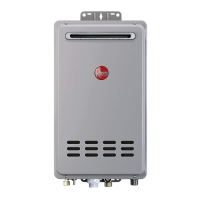Safety
3
IMPORTANT SAFETY INFORMATION
DANGER
FLAMMABLES
Flammable Vapors
Water heater has a main
burner flame.
The main burner flame:
1. which can come on
at any time and
2. will ignite flammable
vapors.
Vapors:
1. cannot be seen,
2. are heavier than air,
3. go a long way on the
floor and
4. can be carried from
other rooms to the
main burner flame by
air currents.
Vapors from flammable
liquids will explode and
catch fire causing death or
severe burns.
Do not use or store flammable
products such as gasoline,
solvents or adhesives in the
same room or area near the
water heater.
Keep flammable products:
1. far away from heater,
2. in approved containers,
3. tightly closed and
4. out of children's reach.
Installation:
Do not install water heater
where flammable products will
be stored or used unless the
main burner flame is at least
18" above the floor. This will
reduce, but not eliminate, the
risk of vapors being ignited
by the main burner flame.
Read and follow water heater warnings and instructions. If
owners manual is missing, contact the retailer or manufacturer.
Water Heater Venting Safety
3
DANGER: Failure to install and properly
vent the water heater to the outdoors as outlined in the
“Venting” section of the Installation Instructions in
this manual will result in death from fire, explosion, or
asphyxiation from carbon monoxide. NEVER operate this
water heater unless it is properly vented and has the air
supply piping properly installed and terminated to the
outdoors.
Be sure to inspect the vent terminal, the air intake, and
the vent system on the water heater for proper installation
at initial start-up and at least annually thereafter. Refer to
the “Care and Cleaning” section of this manual for more
information regarding vent system inspection.
WARNINGS:
• Gasoline and other flammable liquids, materials,
and vapors (including paint thinners, solvents, and
adhesives) are extremely dangerous. DO NOT handle,
use, or store gasoline or other flammable or combustible
materials anywhere in the vicinity of a water heater
or any other appliance. Be sure to read and follow the
labels on the water heater, as well as the warnings
printed in this manual. Failure to do so can result in
death, bodily injury, or property damage.
• Combustible construction refers to adjacent walls and
ceilings and should not be confused with combustible
or flammable products and materials. Combustible
materials, such as clothing, cleaning materials, or
flammable liquids, should never be stored in the vicinity
of this or any gas appliance. Fire or explosion can occur
causing death, personal injury, and/or product damage.
See page 29 for clearances to combustible materials.
• Follow vent manufacturer’s instructions for venting
installation, including additional clearances from
combustibles, to avoid conditions that can lead to
death, personal injury, and/or property damage.
• Use tankless water heater manufacturer-approved
Schedule 40 PVC (foam core is not permitted at any
time), Schedule 80 PVC, CPVC, ABS, or UL 1738-listed
Category III Stainless Steel. No other vent material is
permitted. For Canada, installations must follow ULC
S636 for exhaust venting.
• Moisture in the flue gas will condense as it leaves the
vent terminal. In cold weather this condensate can
freeze on the exterior wall, under the eaves, and on
surrounding objects. Some discoloration to the exterior
of the building is to be expected. However, improper
location or installation may result in severe damage to
the structure or exterior finish of the building.
• For multiple-unit installation, a minimum distance
between vent terminations must be maintained to prevent
recirculation of vent gases. See page 39 for information
on venting and clearances to multiple terminations.
CAUTIONS:
• Ensure that the appliance vent is securely glued and
attached to the vent connection on the top of the water
heater. DO NOT USE SCREWS.
• D o not operate without the condensate drain connected
and routed to a proper drain.

